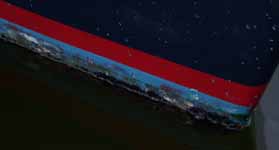
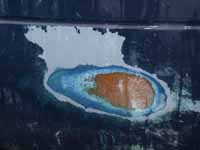
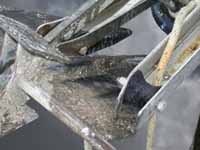

Just before Thanksgiving, 2003, I headed down to Belize to rebuild the engine in my sailboat, Malakii. I had left the boat in a marina near Belize city and flown home in April to have my arm operated on. Since then, the managers of the marina had quit and returned to Florida, and all of the boats permanently moored there had moved to other locations because of the poor security. Rumor has it the bar, restaurant and apartments were being run as a pretty wide open hard partying bordello and who knows what else. I was concerned there would be quite a bit missing from my boat.
The day after I arrived, using a thirty or so foot tender with twin 200 hp outboards, we rescued Malakii from the now defunct marina. Her bottom and bootstripe were hosting a maritime museum. The dock lines had stretched and sagged into the water, with the result that they too were barnacle encrusted. Before I realized I needed gloves, I cut my hands casting off. We towed her to a new marina (Cucumber Beach Marina) about five miles south of Belize City. It was a slow trip to the marina, owing to her barnacle-encrusted bottom. I had some difficulty turning the rudder, and the depth sounder gave only very sporadic readings. We got to the new marina well after dark. Malakii was somewhat the worse for wear as a result of lying neglected for five months. There was a spot on her topsides which was rubbed bare down to the fiberglass, a result of stretched dock lines and fenders no longer being positioned correctly. In my haste to return home to have my arm operated on, I had not removed the jib from the forestay, and had trusted to its being protected by the sailbag. Unfortunately, the zipper had come completely undone, and the sail had chafed on some anchor chain with the result that the sail had several small tears.
 |
 |
| Malakii's Barnacle Encrusted Bootstripe | Rubbed Topsides |
 |
 |
| Damaged Bow Rollers and Barnacle Encrusted Anchor | Damaged Sail |
But other than that, she had weathered some months of neglect fairly well. Nothing was missing, except my book on sailboat repair, of all things.
Cucumber Beach Marina is still under construction, but will be a nice facility when completed. It has excellent security, and good water and power. A bar but no real restaurant at the moment. There's cable television for those who can't do without it, but no internet facilities. Showers and laundry facilities are planned but not yet operational, as are dockside apartments. But no swimming pool. It's not convenient to town for provisioning, or the airport for picking up guests. However, you can catch a bus to town for $1 Bz, and another $1 Bz gets you close to the airport. Taxis are expensive, $20 Bz to town and $60 Bz to the airport. Which is why I take the bus if possible. I have better uses for that money, and the exercise is good for me. Besides, I see a different side of Belize and her people that way.
Picture this, something I observed a few days before returning home. It's hot, unbearably hot, and humid. HOT, sticky, HOT. There's a bus stop in a run-down neighborhood. At some bus stops, there's a covered area in case of rain that also provides shade, but at this one the only shade around is that from a telephone pole. Everybody lines up, standing in the shade. Not your normal line where there are bunches of people here and there, but a very thin line, barely one person thick. People turned however they need to to maximize their area in the shade, minimize that in the sun. It would make a great photograph. I lined up early on, before I was aware of the phenomenon, and it was very very noticeably cooler. Nobody cut in line...
I spent the next few days tidying up, inventorying the damage and deciding how best to use my limited time. A few days later my mechanic, Bill McKenzie, showed up. Our original plan was to rebuild the engine in place, but after looking things over we decided it would be pretty easy to take the engine out completely. So we unbolted the drive shaft, disconnected the gearshift and throttle, disconnected the cooling water and exhaust hoses, disconnected the fuel lines, and unbolted the motor mounts. We took off the forward part of the engine compartment, and voila! we slid the engine out.
The engine is an 18 Hp Kubota D850B, a three cylinder diesel. It's fairly light, weighing something like 180 pounds. Fairly light is a relative term, but we could hoist the engine out using the main halyard and a winch. Then we carried the engine to Bill's truck and I gave him a bucket of parts and my engine manual.
It would be a while before I saw the engine again. The valves needed to be seated, and of the three head shops in town, only one was still operating, so it was swamped. Unfortunately, not all of the parts I'd bought in Montana at my friendly Kubota tractor dealer were correct -- the valve guides were too small. Fortunately, five of the old ones were still good, but the sixth was useless. The head shop had to machine a new one from scratch.
In the meantime, I took the opportunity to reroute the wires running from the batteries through the engine compartment. They still run through the engine compartment, but are now tucked more out of the way. I also cleaned the whole thing and painted it, hoping a clean room to start with will inspire me to keep it clean. It makes discovering leaks and problems a lot easier.
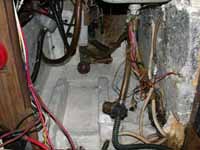 |
| Repainted and rewired engine compartment.
Those wires on the right hook up to the engine. The hoses are for the bilge pump and galley sink drain and faucets. |
The cabin was a bit dingy, I finally realized, owing to the mold which tends to grow on everything in a warm moist climate. I spent a day with a bleach rinse washing everything down, and it was much cheerier inside after that.
One of the things which has caused me a lot of trouble is the lack of some critical deck hardware, notably midrail cleats. When I realized I was going to have more time on my hands, I purchased some cleats, made some backing plates, and installed them. I'm hoping they will allow me to lash the dinghy on the foredeck for short crossings, serve as a jib lead block tie point for the small 70% jib, and serve as a boom preventer tie point, as well as be useful for attaching spring lines when at the dock.
 |
| Finally, midrail cleats |
My drill is what used to be a portable one, but the handle is broken off, so the battery compartment is totally gone. It came with the boat, so I guess I can't complain. I wire it to the battery, and it works fine. When installing the cleats, the trigger popped off, something it's never done before... and landed in the water. Bummer. The water in the marina isn't crystal clear, but at least it's not horribly dirty either. I put on my mask and fins, and spent a half-hour looking for the small (about 1-1/4" long) black trigger, with no success. I finally gave up and borrowed a neighbors drill to complete the job. Around noon, I moved the boat over a foot to allow more sunlight to hit the water, and with the sun higher in the sky and the dock not shading the bottom, I tried again. On my first sweep, I found it. That was a big relief.
Another problem has been the lack of cleats on the cabin top. When sailing single-handed, I rig jacklines from the anchor windlass on the foredeck back to the cleats on the cabintop. I clip into these with a tether hooked to my harness, so that if I slip or get knocked about, I won't fall overboard. Or if I do, I'll at least still be attached to the boat, and hopefully able to climb back aboard. Unfortunately, Malakii only has two cabin top cleats, and if I use those for jacklines, it makes other things difficult, as there is nothing to cleat a line to after coming off the cabin-top winches. There are rope clutches ahead of the cabin-top winches, but some are broken and the rest are too small for the existing lines on the boat. Furthermore, one of the existing cabin-top cleats is an old wooden one which is screwed, not bolted, into the cabin-top, and I am not very confident of its holding power.
So I added two additional cleats, through bolted with backing plates. In the pictures below, you can see the old cleats are at two different angles relative to a line coming off the winches. The wooden one is at too large an angle, so some day I should remove it and replace it with a thru-bolted one set at a better angle.
 |
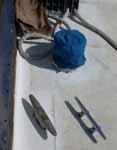 |
| New cabin top cleats |
Then I took the rope clutches apart to clean them, and discovered that the handles are reversible with slightly different geometries. One orientation is for small diameter lines, and the other is for larger diameter lines. They were all positioned for small diameter lines, which is what this boat really needs. However, some former owner had replaced the lines with second hand ones which are all oversize. Apparently the owner didn't understand how the clutches worked, and tried to force them down on the oversize lines. The result is that half of them are broken, and the remaining ones don't work with the existing lines. I reversed the remaining good ones, allocated them where they would be most useful, rerouted the halyards so they ran fairer to the winches, and brought some broken handles home with the idea I will make some replacements, since they are no longer available.
The cockpit had a single speaker in it which had never worked, the primary reason being that it was no longer hooked up. The secondary reason being that it was busted. As such, it made a great hole in the cockpit where water could enter. Since I would rather listen to the world outside than electronic entertainment, and since the boat is small and already has a good set of speakers in the saloon, I decided to get rid of the hole in the cockpit. It's unsettling to be sailing along in a storm with water crashing all around you and look at that hole in the side of the cockpit. So I scrounged up a piece of fiberglass, cut it to size, and screwed and sealed it over the hole. I didn't want to totally seal the hole with fiberglass just yet, as I might decide to make some kind of pocket to store things in.
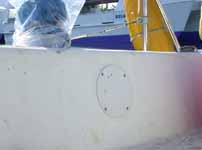 |
| Former speaker hole |
The lifelines on Malakii need replacing, but I haven't yet gotten the time and money to do that. I keep thinking if I am going to replace the lifelines I probably need to replace some of the stanchions as well, and suddenly the whole thing is a pretty big job, and not at the top of the list yet. However, there is some old ratty string woven between the lifelines that is mostly useless, except that a part of it keeps the jib from sliding over the side when it's doused. Or at least that's what it seems like to me. So I got rid of the old ratty lines and replaced a short section with new stuff. I'm still not sure I want it there at all, but right now I think it's still useful.
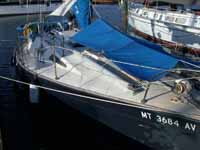 |
| New lifeline netting |
When I first bought Malakii, I was aware that she didn't have all the requisite safety equipment on board. One of the main missing items was a fire extinguisher. This didn't bother me too much, since her old gas engine has long since been replaced by a diesel. However, I did have a little excitement the first time I filled the alcohol stove. I knew enough not to try to fill a hot stove, but I thought I would be smart and fill the canister while it was sitting in the stove enclosure, a stainless sheet metal bin about the size of a two burner coleman stove and eight or ten inches deep. Seemed like a good idea, since any spilled alcohol would be contained in the bin. However, it is pretty difficult to clean up every little drop of errant alcohol, and one should wait a while for the last vestiges to evaporate. When I went to light the newly refilled stove, I had, uh, a little more flame than I needed to boil my cup of tea. And no fire extinguisher. Fortunately a towell was at hand, and I smothered the fire ok. But I did decide to get a fire extinguisher. It's now mounted next to the nav table, accessible from the galley and not too difficult to get at from the cockpit. The other orange canisters under the nav table contain flares.
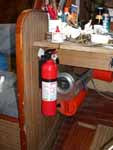 |
| At last, a fire extinguisher |
The galley on Malakii, and most small boats in general, is pretty cramped and awkward. It's hard to store things so they are accessible yet will stay put when under way. The former owners had made some storage holders using short tubes of pvc screwed to the wall. I decided to extend the concept and lined the back of the counter with holders of several sizes. That space is pretty much useless otherwise, so I think it will work well.
 |
| Galley improvements |
I got quite a few other things done while waiting for the engine:
There! Who said there's nothing to do??? I also spent a fair amount of time measuring and cogitating future improvements. I'm particularly interested in being able to fly a spinnaker, and would like to have a real refrigerator instead of an icebox. But I'd like that refrigerator to run off solar power mostly, so I don't have to run the engine every day. So I checked out the insulation in the ice box, figured some electrical loads, and looked at space and electrical requirements of refrigeration units suitable for use in the tropics.
At long last, the engine was ready. It arrived freshly painted. We lowered it into the boat with the same halyard / winch arrangement used to raise it, then reconnected everything. Hit the glo plug, hit the starter... nada. We had fuel to the injectors, and white smoke out the exhaust. The compression was good. After an hour or so of putzing around, we let her rest and went to have a beer. Bill said if we could just get it to turn over once, then the rings would start to seat and everything would be ok. I was having my doubts. We finally connected the two batteries in series so we had 24 volts instead of 12. The starter really cranked, but still nothing. Reluctantly, we gave her a squirt of ether, and she coughed. Then she sputtered to life and ran. Part of the problem may be bad fuel, as the fuel in the tanks has been there for ten months or so. In the tropical heat, it tends to get algae growing in it. We ran the engine for an hour or so. It sounded ok, but a little rough on one cylinder at some speeds. That could be either a dirty injector or the bad fuel. However, after that initial start, the engine continued to start and run, including the next morning when it wasn't warmed up. So that was very good news.
It was my last day before my plane ticket home. Unfortunately, my ticket was only good for 30 days, and I couldn't extend it. If I wanted to delay, I would have to buy a whole new ticket. I decided to leave Malakii in the marina and fly home for the holidays. The plan is to return in early February, get the engine running smoothly, then spend a month or so cruising. I hope to visit the outer atolls of Belize, and maybe Xcalak and Banco Chinchorro in southern Yucatan. There's a small chance I may take a quick trip to Roatan.